Camel is a large, strong desert animal with one or two humps on its back. The humps contain stores of fat that provide energy for the animal when food is scarce. Camels live in Asia, Africa, and Australia. They can travel great distances across hot, dry deserts with little food or water. The animals walk easily on soft sand, where trucks would get stuck. They can carry people and heavy loads to places that cannot be reached by road.
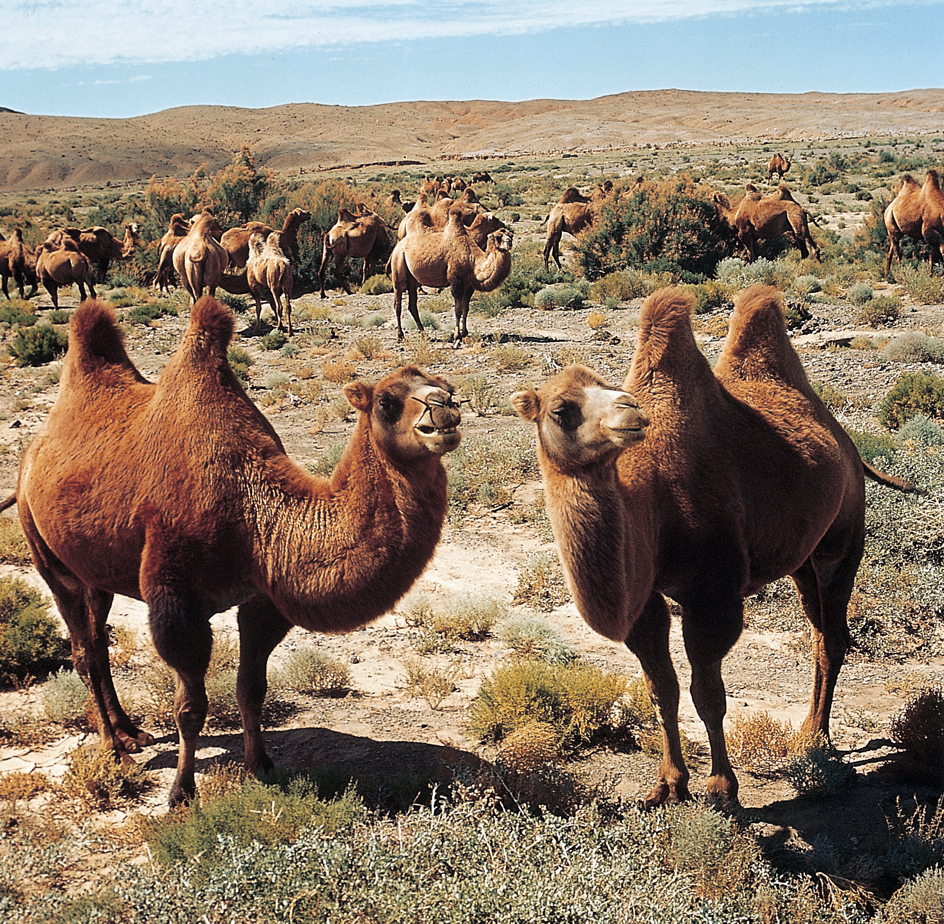
People have domesticated camels for thousands of years. Arabian camels may once have roamed the Arabian Peninsula, but no wild camels remain there. Desert-dwelling peoples of Africa and Asia keep several million domesticated Arabian camels. The first Bactrian camels probably inhabited Mongolia and Afghan Turkestan, an area associated with the ancient region of Bactria. Perhaps a few hundred wild Bactrian camels still survive in Mongolia, and over a million domesticated ones live in Asia.
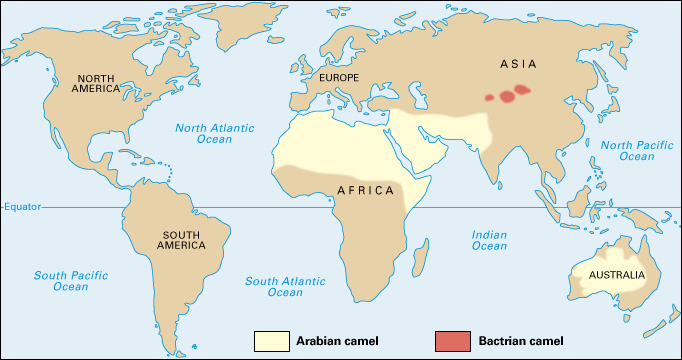
Studies of fossils and other evidence suggest that members of the camel family lived in North America at least 40 million years ago. By about 2 million years ago, the ancestors of modern camels had developed into a distinct species and moved westward across Alaska into Asia. In Asia, two groups separated and gradually became the two chief kinds of camels known today. Meanwhile, smaller members of the camel family had moved southward from North America to South America. Today, four members of the camel family live in South America: (1) alpacas, (2) guanacos, (3) llamas, and (4) vicuñas. By the time Europeans came to North America, no members of the camel family had lived there for many thousands of years. Scientists have not determined why North American camels became extinct.
During the 1850’s, the United States Army imported about 120 camels from Africa and Asia to carry cargo from Texas to California. But the railroads, growing rapidly by then, could carry more goods faster and cheaper than the camels could. The Army sold the animals, primarily to circuses and zoos. A few camels escaped and lived wild in Arizona until at least 1905.
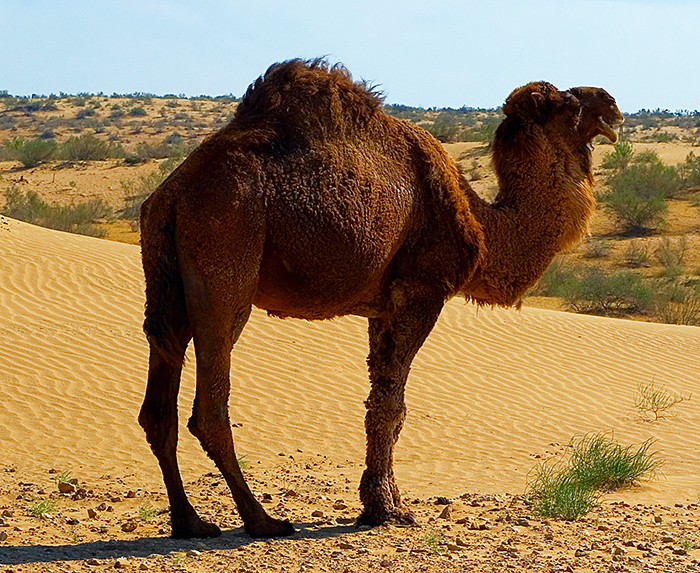
Beginning about 1840, people in Australia used camels to help them explore and settle that continent. Today, about 1 million camels roam wild in Australia. They have become a major threat to many native plants and animals.
Camels and people
Millions of people who live in Africa and Asia depend on camels to fulfill most of their basic needs. In lands at the edge of the deserts, camels pull plows, turn water wheels to irrigate fields, and carry grain to market. Deep in the deserts, camels serve as almost the only source of transportation, food, clothing, and shelter. In turn, camels need people to draw water for them from wells so that the animals may survive the hot summers. 
Camels work hard, but they behave unpredictably. Bactrian camels can spit, and all camels can kick. Camels may groan and bawl when they are loaded with cargo and forced to rise to a standing position. However, they routinely carry loads of up to 330 pounds (150 kilograms) for eight hours. They can carry more but do so unwillingly. Usually, camels work only six months of the year. If driven too hard, they will die from overwork.
Camels provide an important source of food in the desert. People eat the meat of young camels, though it can be tough. They melt fat from the animal’s hump and use it like butter. People drink camel’s milk and also make cheese from it.
The camel also supplies wool and leather for clothing and shelter. People can weave the animal’s soft, woolly fur into fine cloth and warm blankets. The long fur of the Bactrian camel works especially well for weaving into cloth. Merchants in many parts of the world sell camel’s hair cloth for making blankets, coats, and suits. Traditional Arab groups use the cloth for much of their clothing and for tents. The strong, tough skin of the camel provides leather for shoes, water bags, and packsaddles. Craftworkers carve dried camel bones into jewelry and utensils. Dried camel droppings serve as fuel for fires where wood is scarce.
The body of a camel
An adult camel stands from 6 to 7 feet (1.8 to 2.1 meters) tall at the shoulder and weighs from 550 to 1,600 pounds (250 to 725 kilograms). Its ropelike tail can reach almost 21 inches (53 centimeters) long. The thick, bushy fur of a camel makes the animal appear larger than it actually is. The fur takes on various shades of brown, from nearly white to almost black. An Arabian camel’s short fur helps protect its body from the heat. The fur of a Bactrian camel grows longer, up to about 10 inches (25 centimeters) long on the animal’s head, neck, and humps.
All camels lose their fur in spring and begin growing a new coat. The fur sheds so quickly that it hangs in large clumps, making the animal appear ragged. A camel looks sleek and slender for several weeks after losing its coat. A thick coat of new fur grows by autumn.
Camels have calluslike bare spots on their chests and leg joints. These spots look as though the hair has been rubbed off, but they occur naturally and not from wear. The thick, leathery skin grows at these spots about five months after the camel’s birth. They help support the animal’s body weight when kneeling, resting, and rising.
The head.
A camel has large eyes on the sides of its head. Long, curly eyelashes protect the eyes by keeping sand out of them. In the daytime, when the sun is high, the eyes do not allow excessive light in. Glands supply the eyes with a great deal of water to keep them moist. Thick eyebrows shield the eyes from the desert sun.
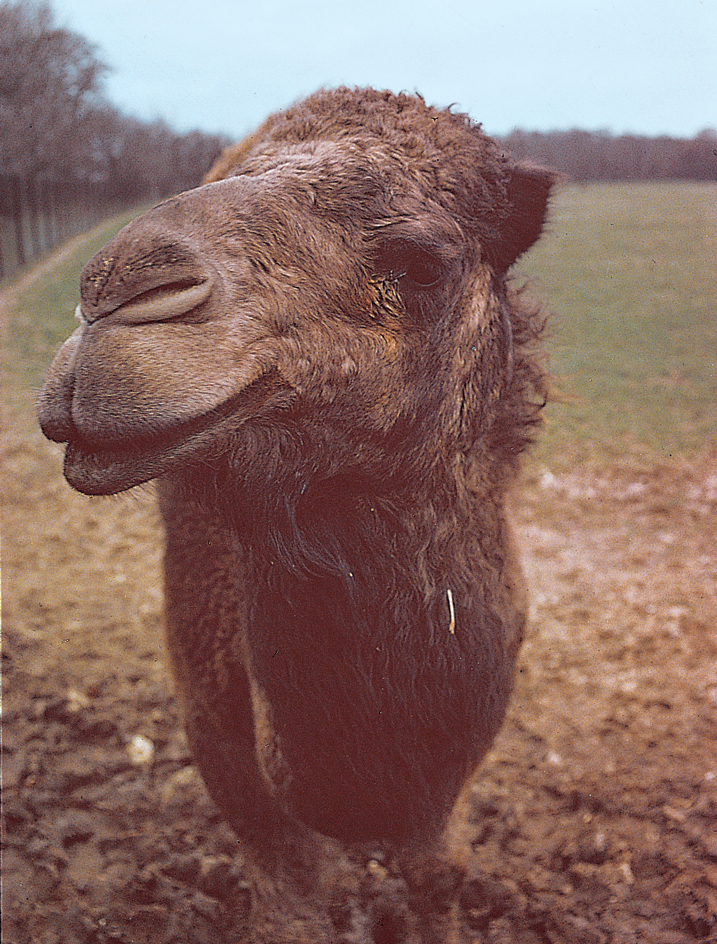
The camel’s small, rounded ears sit far back on its head. Hair covers the ears, even on the inside. The hair helps keep out sand or dust that might blow into the animal’s ears. A camel can hear well, but, like the donkey, it often pays no attention to commands.
An adult camel has a large mouth with 34 strong, sharp permanent teeth. Camels may use their teeth as weapons, biting viciously if frightened or angered. A camel owner may cover the animal’s mouth with a muzzle to keep it from biting. A working camel cannot wear a bit and bridle, as a horse does, because the equipment would interfere with the chewing of cud (partially digested food). Instead, many camel owners lead the animal using a rope attached to a harness or to a small peg that pierces the camel’s skin near the nose.
The hump
of a camel consists mostly of fat. Bands of strong tissue hold the pads of fat together, forming a lump above the backbone. The hump of a healthy, well-fed camel may weigh 80 pounds (36 kilograms) or more.
Most kinds of animals store fat in their bodies, but only camels keep most of their fat in a hump. If food becomes scarce, the animal can use the fat in the hump to provide energy. A starving camel exhibits a shrunken hump. The hump may even slip off the animal’s back and hang down on its side. After the camel has spent a few weeks resting and eating, its hump becomes firm and plump again. The hump does not serve as a storage place for water, as many people believe.
Loading the player...Camel
The legs and feet.
Camels have long, strong legs. Powerful muscles in the upper legs enable the animals to carry heavy loads over great distances. A camel can carry as much as 1,000 pounds (450 kilograms), but a typical load weighs about 330 pounds (150 kilograms). While working, the animals normally travel about 25 miles (40 kilometers) a day at a speed of 3 miles (5 kilometers) per hour. Camels usually walk, especially in the heat. When they must go faster, camels either gallop or pace. The pace is a medium-speed movement in which both legs on the same side lift together and come down together. This action produces a swaying motion that makes some riders “seasick.” For this reason, people sometimes call the camel “the ship of the desert.”
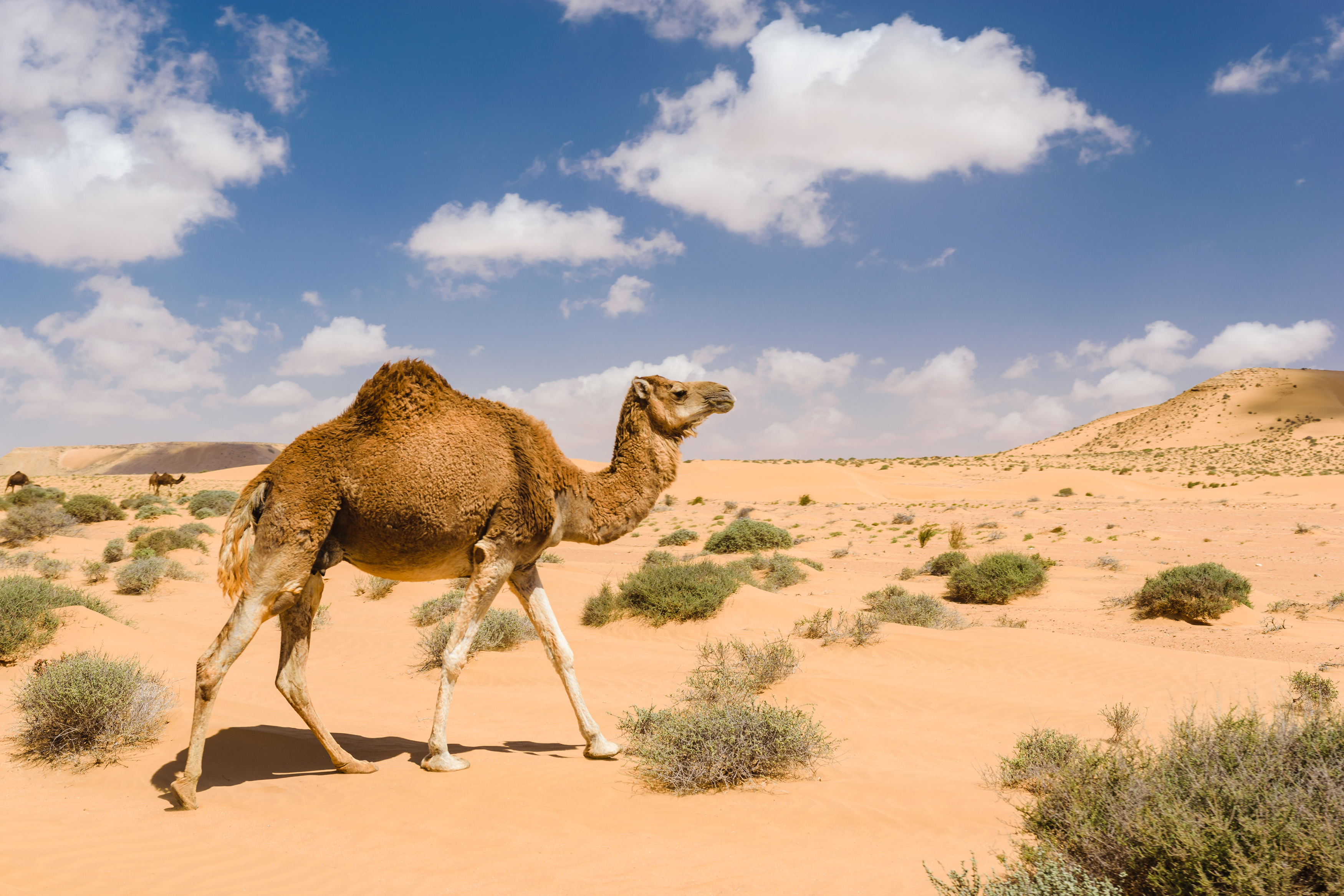
When a camel kneels to rest, it first bends its front legs and drops to its knees. Then it folds its hind legs and sinks to the ground. To get up, the camel straightens its hind legs and then jerks up to extend its front legs. A camel can lie down and stand again even with a heavy load on its back.
Camels have two long toes on each foot. A hoof that resembles a toenail grows at the front of each toe. Cows, horses, and many other animals walk on their hoofs. But the camel walks on a broad pad that connects the two toes. This cushionlike pad spreads when the camel steps on it. The pad supports the animal on loose sand in much the same way that a snowshoe helps a person walk on snow. The camel’s cushioned feet make almost no sound when the animal walks or runs.
The life of a camel
From birth, camels must learn to survive and work in harsh desert conditions. They lead lives adapted to enduring extremes of hunger, thirst, and heat.
Young.
A female camel carries a single baby, called a calf, inside her body for about 13 months before giving birth. The calf’s eyes are open at birth, and a thick, woolly coat covers its body. Just a few hours after birth, the calf can run. It calls to its mother with a soft “baa” somewhat like that of a lamb. The young camel and its mother live together for several years unless forcibly separated.
Camel owners begin to teach the animals to stand and kneel on command at about age 1. The young camel also learns to carry a saddle or small, light packs. The owner gradually increases the size and weight of the packs as the camel grows older. A 5-year-old camel can carry a full load.
Food.
Camels can go for days or even weeks with little or no food. People who live in deserts feed their camels dates, grass, and such grains as wheat and oats. In zoos, the animals eat hay and dry grains—about 8 pounds (3.6 kilograms) of each every day. When traveling across the desert, a camel may have difficulty finding food. The animal may have to live on dried leaves, seeds, and whatever desert plants it can find. A camel can eat a thorny twig without hurting its mouth. The mouth of a camel has such a tough lining that sharp thorns cannot push through the skin. When food becomes scarce, a camel will eat anything—bones, fish, meat, and even leather or cloth if not carefully watched.
A camel does not chew its food thoroughly before swallowing it. The animal’s stomach has three sections, one of which stores the partially chewed food. This food later returns to the mouth as a ball-like glob of cud, which the camel chews. The camel then swallows the food, which goes to the other parts of the stomach for further digestion. People call camels, deer, cattle, and other kinds of animals that digest their food in this manner ruminants (see Ruminant ).
Water.
A camel can go without drinking water for days or even months. The amount of water a camel drinks varies with the time of year and with the weather. Camels need less water in the cool winter weather, when the plants they eat contain more moisture than in summer. Camels that graze in the Sahara can survive all winter without water and may refuse to drink if offered water. But in hot weather, a large, thirsty camel can drink up to 50 gallons (200 liters) of water in a single day.
A camel needs little water each day because it gets some moisture from its food. Also, a camel retains most of the water that is in its body. Most animals sweat when hot, and the evaporation of the water from their skin keeps them cool. But camels do not sweat much. Instead, their body temperature rises by as much as 11 Fahrenheit degrees (6 Celsius degrees) during the heat of the day and then cools down at night. In people, an increase of only one or two degrees indicates illness.
On hot days, a camel keeps as cool as possible by resting rather than feeding. It may lie down in a shady place or face the sun so that only a narrow part of its body receives the sun’s rays. A group of camels may fight off heat by pressing against one another because the body temperatures of the camels may be lower than the air temperature.
